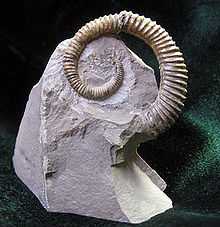Allocrioceras
| Allocrioceras Temporal range: 99.6–85.8Ma | |
|---|---|
 | |
| Fossil Allocrioceras pariense from Utah | |
| Scientific classification | |
| Kingdom: | Animalia |
| Phylum: | Mollusca |
| Class: | Cephalopoda |
| Subclass: | Ammonoidea |
| Order: | Ammonitida |
| Suborder: | Ancyloceratina |
| Superfamily: | Turrilitaceae |
| Family: | Anisoceratidae |
| Genus: | Allocrioceras Spath, 1924 |
| species | |
| |
Allocrioceras is an ammonoid cephalopod from the mid-Cretaceous included in the turrilitacean family Anisoceratidae. Its shell is strongly ribbed and is in the form of a widely open spiral.
Classification
After its 1907 discovery, the species A. hazzardi was erroneously classified as Crioceras latus by Udden. A later 1928 revision by Adkins removed it from the species C. latus while keeping it as a member of the Crioceras genus. In 1963 Young gave the species its final classification in a new genus- Allocrioceras.
Biology
Allocrioceras was small compared to some Ammonites. Its shell diameter was only a bit larger than an U.S. quarter. Unlike most Ammonites its shell was partially uncoiled. Ammonites like this, with shell configurations differing from the typical tightly coiled spiral, are called Heteromorphs. It lived approximately 88 million years before present during the Turonian stage Cretaceous Period in what is now Texas. Its fossils can be found in the limestones of Brewster and Terrel counties.
Its stomach contents and some soft parts have been found.[1]
References
- ↑ Wippich, M. G. E.; Lehmann, J. (2004). "Allocrioceras from the Cenomanian (mid-Cretaceous) of the Lebanon and its bearing on the palaeobiological interpretation of heteromorphic ammonites". Palaeontology 47 (5): 1093–1107. doi:10.1111/j.0031-0239.2004.00408.x.